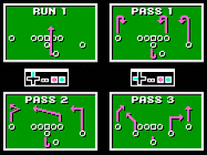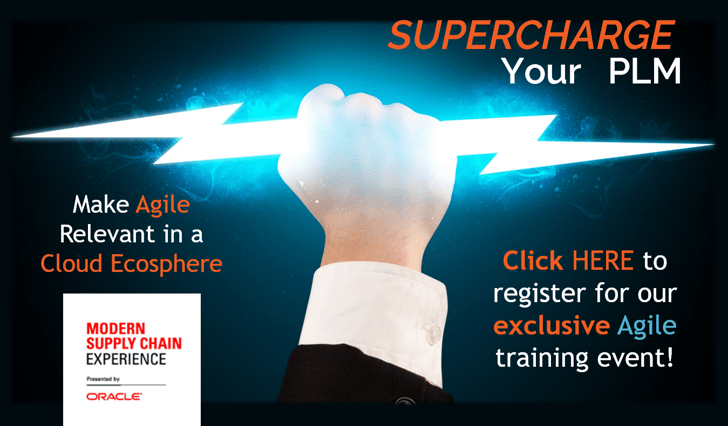Since Oracle Modern Supply Chain Experience (MSCE) 2017 is right around the corner, I thought I'd use this post for today's TBT blog.
As promised I am trying to chronicle the highlights from the first annual Oracle Value Chain Summit in San Francisco. Building on the success of last year's PLM only event Oracle has collocated several of their product lines from the application side of their business for a focused event on how Oracle drives business value. The event sold out from an attendance perspective and there are 300 people here just for Agile PLM which is by far the largest percentage of attendees based on product lines. Oracle is known for using their influence ($$) to draw some well know speakers but I was still surprised to see John Madden's name on the schedule as a speaker for the first day of the event. As someone who has made some big reaches to try and tie PLM into everyday life I was interested in how Oracle would make this relevant to enterprise software and business process. The speaker from Deloitte had the unenviable task of preceding Madden in a ten-minute window. In fairness I walked into his presentation mid-stream so it didn't really resonate with me until he got to his last two slides. He was smart to know his audience and the slide he brought up was the original Madden NFL game from 25 years ago and then a slide of the current version. The excellent point he made was that over this 25-year period this game had changed significantly. The strides that have been made are amazing especially when you see the original game which was a major breakthrough at the time compared to the live quality of the newest version. Obviously, a lot of things have combined to deliver this improvement but he asked the question about how business software has transformed or will transform over the next 25 years? What will be the innovations delivered to the market and will they be as striking in contrast as these two versions of software. This of course got me thinking about Product Lifecycle Management and what will be the major changes in the future that will allow companies to transform their process. This article will discuss some ideas on what the future of PLM looks like and how John Madden's wisdom can be applied to our space.
When Madden finally took the stage he kind of lumbered up and plopped into a chair and I was very curious to see if he would be able to relate to his audience. Wisely, Glenn Seninger, Oracle Group Vice President kept the topic on football which kept the male dominated audience attentive. When Madden discussed the reputation his team's had for being free spirits he made an interesting point about rules that I think can apply to PLM. He said when coaching he only had three rules, "be on time, pay attention, and play like hell when I say so". I am pretty sure he meant play hard when I say so but you get the point. He acknowledges that many other coaches have an extensive list of rules including what type of shirt they should where, how long their hair could be, whether they could have facial hair etc. His point was that if you have too many rules then people will end up assigning their own priority to the rules and this priority may not be aligned with reality. By giving people too many rules you give them the opportunity to inadvertently circumvent the intent of the rules or as we have discussed in a previous blog be "maliciously obedient" in defeating the original purpose. I think this is a great point to apply to PLM deployment especially around security. The more restrictions and rules you put in place the more you relieve your end users of the responsibilities of ownership of the development process. While some may argue this is a good thing I contend it is important to balance the level of restriction in a way that allows end users to be engaged in the process. Moreover, the more rules and restrictions you put in the system the more points of maintenance you have created for administration. When deploying PLM, it is best to take a lean approach to your methods and question every restriction you put in place. Some are essential and access control is one of the value drivers for PLM but it needs to be applied with restraint. If you tie your system up with permissions, it can become very difficult for people to do their job and they will develop work arounds to the system.
The other interesting point Madden made was in regards to the video game. When it was originally developed he envisioned it being used as a teaching tool to help coaches evaluate the quality of play versus different defenses. He did not expect it to become the iconic symbol of video football. He stated if "I had set out to build a football game that would dominate the market for 25 years it wouldn't have happened." The point he was making is that when you plan up front you can never really fully anticipate what is going to happen. I believe this is true in product development and in the deployment of enterprise software. You have to stay somewhat flexible and allow for adjustments as you gain more data or better understanding of your business needs. The situation can be somewhat fluid and priorities and requirements can shift. Obviously you have to balance this with the need to "publish" as Seth Godin states in his book Linchpin but adhering to rigid plans come "hell or high water" can lead to ruin and often does. We are working with a client right now that has experienced some of the challenges that come with rigid plans and they have elected to break up their deployments into discovery element that are tightly focused on specific business issues. Once the discovery is conducted we help them scope the deployment around that specific business need. This method allows them to adjust as they go and to potentially shift priorities as they get feedback from their users. While this approach may be costlier from an overall perspective versus going with a fixed bid for a larger initiative it ultimately delivers exactly what the business needs to accomplish their objectives. If your company has the patience for this type of approach I believe it will yield better results in the long run. Even with fixed bid projects change orders come into play and they create friction between the consultants and the client and tension internally within the client. This approach alleviates the need for change orders in the implementation process.
I want to circle back to the comments from the Deloitte speaker about the future. After the presentation I was discussing what would be disruptive technology for PLM with several very experienced PLM consultants and Oracle PLM sales resources. One of the areas that continues to challenge PLM is the lack of flexibility when it comes to modifying an in place deployment of PLM. Most PLM systems offer limited interfaces and capabilities in this area and given the dynamic nature of business this is a shortcoming. Having the ability to graphically manipulate the configuration of PLM in an unfettered way would empower companies to control their own destiny and significant reduce the cost of ownership for PLM. My idea received mixed reviews from my audience with some saying this type of development would be difficult to justify since it would not drive more revenue for vendors while others thought it could be a competitive advantage that would drive sales. We also discussed improving the integration technologies to allow easier configurations and set ups. Today's integration technologies require significant amounts of customization which is usually accomplished through coding of some sort. This customization is very specific and maintaining it usually requires dependence on external resources. More and more of our customers are asking us how they can maintain these integration points themselves and having better more polished tools would enable these companies to maintain their own integration. Oracle's vision for Fusion and the Application Integration Architecture (AIA) may ultimately provide this capability. Hopefully, it won't take 25 years.
Surprisingly. John Madden had a lot to say about enterprise software even if he didn't know he was saying it. The lessons we can learn from him boil down to keeping our processes as simple as possible and being flexible as we roll out solutions to the enterprise. As with most things there are constants regardless of whether you are coaching a football team or trying to develop or deploy technology and we ignore these lessons at our peril. I am glad I got the chance to hear Madden speak and hope that I will remember his advice as I continue to try and help companies effectively adopt technology. I would be very interested in opinions from others on what they see as the potentially disruptive capabilities that could be introduced to PLM and hopefully somebody will be paying attention and put it into their products.
[Edit: re-post from 2013]



